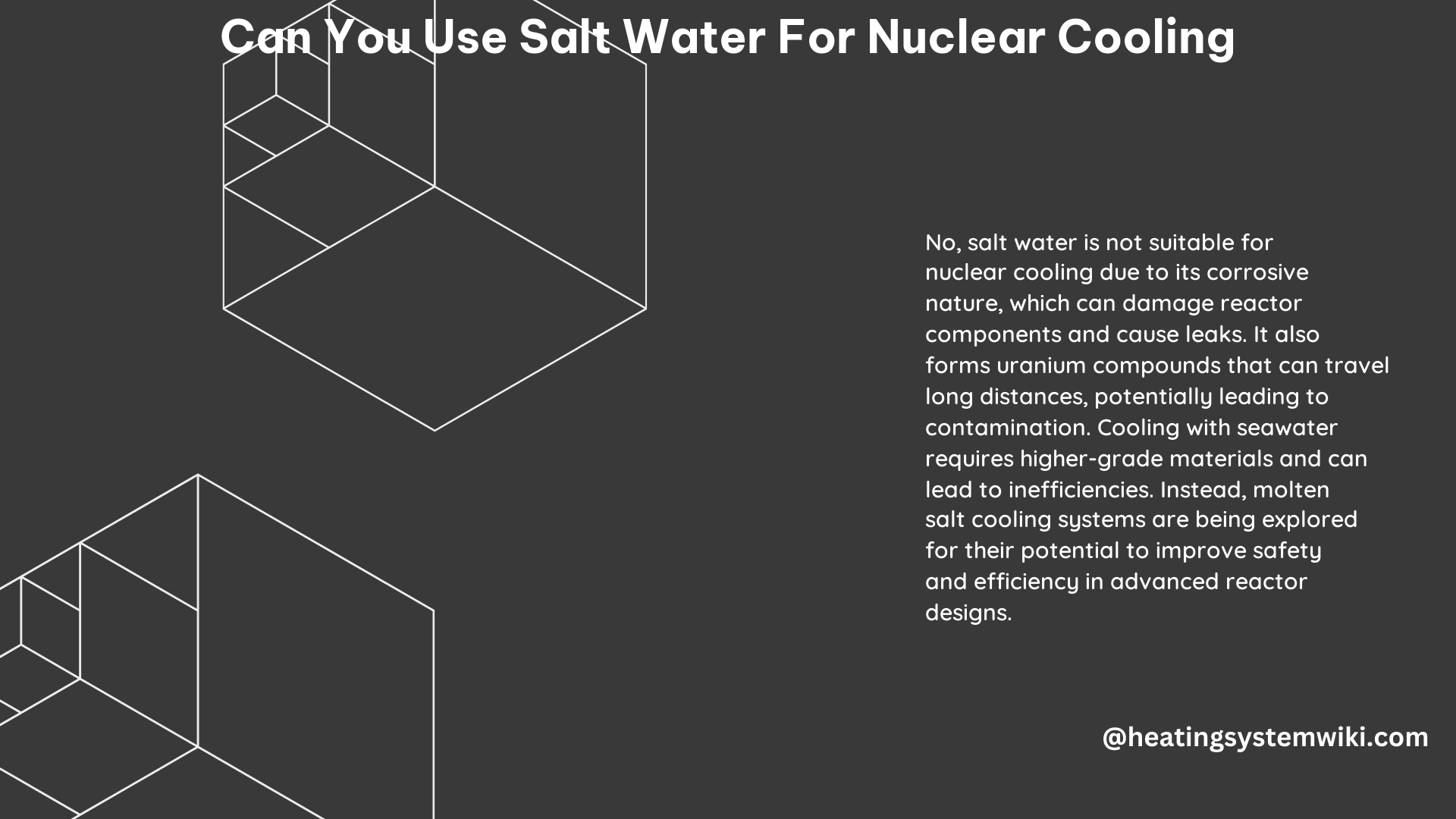Using salt water for nuclear cooling is technically possible, but it comes with significant challenges and is generally considered less efficient than using fresh water. This comprehensive guide delves into the technical specifications, potential benefits, and drawbacks of employing salt water in nuclear cooling systems.
Technical Specifications
Molten Salt Cooling Systems
One of the most promising approaches to using salt water for nuclear cooling is the molten salt cooling system. These systems utilize a fluoride-based salt coolant, such as the Flibe (Fluoride-Lithium-Beryllium) salt developed by Kairos Power. The key advantages of molten salt cooling systems include:
- Temperature Range: The molten salt remains liquid at high temperatures, up to around 600°C, allowing for more efficient heat transfer and electricity generation.
- Atmospheric Pressure: Molten salt cooling systems operate at much lower pressures compared to water-cooled systems, enhancing safety and reducing the risk of catastrophic failures.
- Liquid State: The salt remains liquid without pressurization up to nearly 1400°C, providing an inherent safety feature.
Fuel Type
Another important aspect of using salt water for nuclear cooling is the fuel type. The Hermes reactor, for example, utilizes tri-structural isotropic particle (Triso) fuel pebbles, which are considered the most robust nuclear fuel on Earth. These fuel pebbles can carry more heat than the same volume of water, making them a suitable choice for molten salt cooling systems.
Potential Benefits

While the use of salt water for nuclear cooling comes with challenges, there are some potential benefits to consider:
- Availability: Salt water is readily available in coastal regions, potentially reducing the need for freshwater resources and making nuclear power more accessible in water-scarce areas.
- Desalination: By using salt water in a heat exchanger, the process of desalination can be integrated into the nuclear cooling system, providing a source of clean water for local communities.
- Inherent Safety: Molten salt cooling systems are generally considered safer than water-cooled systems, as they operate at lower pressures and the salt remains liquid at high temperatures, reducing the risk of catastrophic failures.
Challenges and Drawbacks
While the use of salt water for nuclear cooling is technically possible, it comes with several significant challenges and drawbacks:
- Energy Efficiency: Boiling salt water requires more energy than boiling fresh water, resulting in a lower overall electricity generation efficiency for the nuclear power plant.
- Water Purification: Desalinating seawater through boiling is less efficient than using salt-selective filters, leading to less efficient water purification for the nuclear cooling system.
- Corrosion: Salt water is generally more corrosive than fresh water, which can shorten the lifespan of the facility’s components and increase maintenance and repair costs.
- Material Requirements: Using salt water in a nuclear power plant would require the use of more corrosion-resistant materials, driving up the overall construction and operational costs.
- Conductivity and Impurities: The conductivity, organic content, and suspended solids in raw seawater are unsuitable for direct use in a reactor coolant system, necessitating extensive purification before it can be used.
Alternative Approaches
Instead of using salt water directly in the nuclear power plant, an alternative approach is to use it in a heat exchanger. This would allow for the desalination of seawater without the risks of corrosion and radiation exposure associated with direct contact with the nuclear cooling system.
DIY Considerations
It is not recommended for individuals to attempt a DIY nuclear cooling system using salt water, as it requires advanced knowledge of nuclear engineering, materials science, and strict safety protocols. However, for those interested in learning more about nuclear power and cooling systems, there are numerous educational resources available online, including videos, courses, and informative websites. It is crucial to approach this topic with caution and prioritize safety above all else.
Conclusion
While the use of salt water for nuclear cooling is technically possible, it comes with significant challenges and is generally considered less efficient than using fresh water. However, with advancements in materials science, desalination technology, and the development of inherently safer molten salt cooling systems, the viability of using salt water for nuclear cooling may improve in the future. It is essential to carefully weigh the potential benefits and drawbacks before considering the implementation of such a system.
